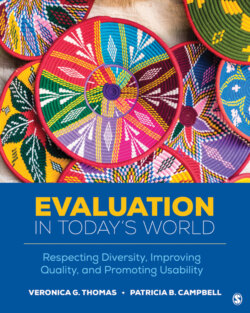Читать книгу Evaluation in Today’s World - Veronica G. Thomas - Страница 25
На сайте Литреса книга снята с продажи.
Race, Racism, Social Justice, and a Racialized Perspective
ОглавлениеAs will be explored more deeply in Chapter 5, race and racism are deeply embedded in the fabric of the United States and have had a complex and destructive influence on the lives of people of color. This influence extends to people’s participation in programs and even the very design of the programs being evaluated. It is critical that evaluators work toward unpacking how bias, in general, but racism, in particular, is a complex and destructive force including in evaluations. Thomas et al. (2018) point out that evaluators have both an opportunity and a responsibility to illuminate the potential impact of race and racism on the programs that they evaluate and the environments that they engage. They urge readers “to gain a deeper understanding of racism as a complex interplay of individual attitudes, social values, and institutional policies and practices and to bring these understandings to the work they do” (p. 515).
Race has been defined as “socially constructed differences among people based on characteristics such as accent or manner of speech, name, clothing, diet, beliefs and practices, leisure preferences, places of origin and so forth” (Ontario Human Rights Commission, n.d., para. 3). The process of social construction of race is called racialization: “the process by which societies construct races as real, different and unequal in ways that matter to economic, political and social life” (Ontario Human Rights Commission, n.d., para. 3). There is no fixed definition of racial discrimination. However, it has been described as “any distinction, conduct or action, whether intentional or not, but based on a person’s race, which has the effect of imposing burdens on an individual or group, not imposed upon others or which withholds or limits access to benefits available to other members of society” (Ontario Human Rights Commission, n.d., para. 2).
“Racism is a wider phenomenon than racial discrimination…. Racism is an ideology that either directly or indirectly asserts that one group is inherently superior to others. It can be openly displayed in racial jokes and slurs or hate crimes but it can be more deeply rooted in attitudes, values and stereotypical beliefs. In some cases, these are unconsciously held and have become deeply embedded in systems and institutions that have evolved over time” (Ontario Human Rights Commission, n.d., paras. 5–6). Racism is pervasive. As entertainer Beyoncé commented, “It’s been said that racism is so American, that when we protest racism, some assume we are protesting America” (Nyren, 2017, para. 4).
Racism operates at a number of levels—in particular, individual, systemic, and societal. It is important to note that “stating that racism privileges [W]hites does not mean that individual [W]hite people do not struggle or face barriers. It does mean that [they] do not face the particular barriers of racism” (Akintunde, 1999, p. 24).
A racialized perspective is one that explicitly foregrounds the impacts of society’s construction of races in ways that are unequal. This can be a difficult thing to do for members of the dominant culture, the group whose members are in the majority or who wield more power than other groups (SparkNotes, 2020). Members of the dominant culture, which in the United States are whites and other people of European origin, can be and often are influenced by the values, or system of thought, in a society that are most standard and widely held at a given time. This is referred to as the dominant paradigm. Being a member of the dominant culture with its standard and widely held values can impact one’s ability to recognize other, different systems of thought and values (Thomas & Campbell, 2017).
In 2018, Thomas et al. (p. 516) put forth five principled beliefs that explicitly guided their thinking about racism. These principles address concerns about dominant cultures and paradigms and guide the thinking of this text related to social programs, social justice, and evaluation of social programs. The principles are as follows:
1 Race is not a biologically determined reality but instead is a socially constructed phenomenon that continues to differentially shape the allocation of power and distribution of benefits and burden among groups within this country.
2 Racism is real, pervasive, and systematic. Race and racism are timeless, endemic, and permanently entwined within the social fabric of American society (e.g., D. Bell, 1995; Delgado & Stefancic, 2001; Feagin, 2013; C. Lawrence, 1995; Solórzano, 1997). As such, racism is not an aberrant but, instead, the natural order of American life, the usual way business is conducted in this society, and a common everyday experience for most people of color. Short-lived victories for persons of color slide into irrelevance as racial patterns adapt in ways that maintain white dominance (D. Bell, 1992).
3 Individual racists need not exist for institutional racism to persist in the dominant culture (Bonilla-Silva, 2018).
4 Racism is not fluid, meaning that it does not flow back and forth, one day benefiting whites and another day (or even era) benefiting people of color. Instead, the direction of power between whites and people of color is historic, traditional, normalized, and deeply embedded in the fabric of U.S. society (DeAngelo, 2011).
5 Race and racism continue to have tremendous consequences for the work of social and behavioral science researchers, and as such, evaluators are certainly not detached from these socially constructed phenomena.
